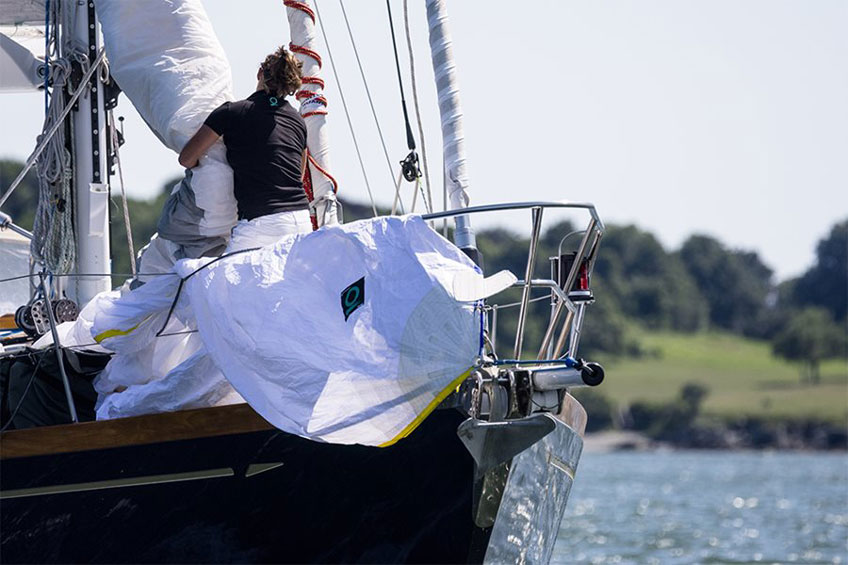The key to sailing successfully downwind with your trusty first mate and actually enjoying it is rooted in preparation. Quantum’s Andrew Waters explains how to prepare and embrace the kite with your partner.

Sailing as a couple is a fantastic experience; however, it can go south quickly. All too often the phrase “Honey, let’s put up the kite” is met with a grimace, bad memories, and a rise in stress levels. Without preparation and the right equipment for the conditions, what seemed like a good idea can quickly go wrong. But with careful set up, communication, and an understanding of your partner’s capabilities, putting up and taking down a spinnaker can be done easily.
HANDLING OPTIONS
Two pieces of equipment that go a long way toward making the deployment and take-down of a downwind sail easier are a spinnaker sleeve and a top-down furling unit. While each takes a different approach to the task, depending on the sail set-up, both will make the exercise easier.
The Spinnaker Sleeve
The spinnaker sleeve is used for a downwind running spinnaker, though it also works well with a reaching sail and both asymmetrical and symmetrical sails. The sleeve that the sail is housed in gets hoisted to the top of the mast and then is pulled up to unveil the sail, allowing you to control the speed with which the sail is opened. The beauty of the sleeve is that it’s forgiving: if something doesn’t appear right, simply pull the sleeve back down over the sail, make the required adjustment, and then start the process again. When it’s time to take the sail down, the process is reversed. Once the sail is completely housed, the spinnaker sleeve is lowered with the halyard and stowed away easily in a duffle bag, ready for the next use.
The Top-Down Furler
The top-down furling unit is best used with reaching sails and Code 0 type sails with straight luffs. It is similar to the spinnaker sleeve in that the sail is stowed and hoisted aloft prior to deploying the sail, but it is rolled around a torsion cable–not too different from the way the genoa might be–and unrolled in a controlled manner with the ability to stop and roll it back up if something doesn’t seem right. Then, as with the spinnaker sleeve, it is stowed aloft by rolling the unit up. When the sail is totally packed away, the top-down furler is lowered to the deck and coiled into its own duffle bag.
PREPARING FOR SUCCESS
Step 1: Choose the right system
Which option is right for you depends on your sail set-up, so speak to your local Quantum expert to make sure you have the correct equipment for your choice of spinnaker.
Step 2: Set it up correctly
The preparation process also applies to the lines: Make sure the sheets are running outside of the boat (shrouds, lifelines, forestay, etc.) and through the blocks correctly. Ensure the halyard is also on the correct side of the forestay and will run freely to the top of the mast. If the sail is asymmetric, ensure the tack line and the tack of the sail are in the correct place at the end of the bow sprit (or the attachment point) before hoisting. If the sail is symmetrical, make sure the guy is in the pole correctly and that the pole is hoisted and set at the correct height with the downhaul/foreguy on to avoid the pole “skying” (or flying up).
Step 3: Execute
Finally, no matter how many times you and your partner (or other crew) have hoisted the spinnaker, it is important that you talk through the tasks at hand.
- Make sure that whoever is at the helm, even if it’s the autopilot, has the correct course set with the preferred wind angle or a landmark reference identified and that the course is maintained.
- Make sure the lines that will be needed–sheets and potentially a guy–are on the winches and safe to operate. If the lines are not needed, ensure they are flaked and clear of potential fouls.
- Ease the mainsheet so that the mainsail will help “blanket” the sail while deploying.
- Discuss the steps and progress as you go so you and your partner are aware of what the other is doing. Make one final check so you know that everything and everyone is ready for the actual unveiling of the sail.
- Once the sail is up, set, and stable, tidy the lines at the mast or in the cockpit and then sit back and enjoy the ride!
Taking down the sail is the opposite of putting it up and still requires the same communication and planning to ensure a smooth and easy process. Don’t wait until the last minute, and give yourself plenty of sea room to execute without a time restraint.
Speak with your Quantum expert about a spinnaker. They’ll make sure you are getting the correct sail for your intended use. As you begin using your spinnaker, get comfortable putting it up in lighter winds and gradually build up wind strength as you and your partner gain more confidence with your process. Spinnakers are a lot of fun and quickly knock miles off a distance passage!